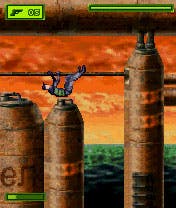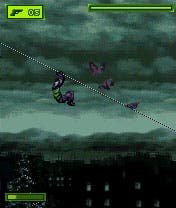Splinter Cell (N-Gage)
Martin assumes the role of a diminutive Sam Fisher. Nothing out of the ordinary.
Poor old Fisher. Sam Fisher, black-clad acrobatic splinter operative of the CIA, that is. Not Donald "Flathead" Fisher of popular Australian soap Home and Away fame. Not at all. What were you thinking? Anyway, old Fisher has had his bar-swinging, ledge-hanging, wall-jumping antics overshadowed recently by some fresh-faced young chap from Persia and his curvy lady-friend embarking on some medieval high adventure through some sprawling castle environs. None of these boring old governmental conspiracy theories, night-vision goggles or skin-tight bodysuits for those athletic whippersnappers, no sir. But ahhhh, what's this? Sammy's got one last trick up his sleeve - his new N-Gage! Oh, wait...
Jeepers creepers...

I thought the original Splinter Cell was amazing when I first clapped eyes on it at ECTS just over a year ago, and again when I finally got my hands on an Xbox copy. That lighting! That animation! He's jumping up the walls and doing the splits! It made me want to be Sam Fisher, poking my little tube camera under doors, disarming wall-mines, peering through walls with thermal goggles and... well you know, doing secret sneaky special agent type stuff.
But after a couple of hours I was quick to realise that actually being a sneaky secret agent type chap isn't all that fun. Firstly, you make one little slip-up and you're booted miles back having inched your way painstakingly through a burning and exploding office complex (or whatever). Secondly, I'm pretty sure most of a sneaky special agent's foes must have night-vision retinas or something, since they were so adept at spotting me in the dark from across a large courtyard (or whatever). And lastly, after you've pulled off that wall-jumping-then-doing-the-splits move about twenty times, it's never really that much fun any more.
So I put it away after about two-thirds of the game. I just gave up, because for all its thick atmosphere and death-defying infiltrations, it ended up just too bloody frustrating to bother. Many moons later and there I was looking forward immensely to controlling Sam Fisher again on a handheld, wondering what kinds of moves he's able to pull off and if he'll still be able to put his fancy goggles to use, as if my finding the original version quite impenetrable had been completely forgotten. My goggles were, incidentally, slightly rose-tinted.
Where'd you get those night-vision/thermal imaging goggles?

Now of course I wasn't expecting Splinter Cell on the N-Gage to play anything like its console incarnation, but further investigation (in my housemate's game collection) revealed that it is in fact an almost direct port of the quite playable Game Boy Advance version. You wouldn't think that a side-scrolling 2D engine would lend itself particularly well to a game dynamic that almost exclusively relies on stealth and considered use of the environment, but Ubisoft has rather impressively forged some brilliant solutions to Fisher's handheld handicap.
Sam has the majority of his repertoire in place, and you'll make use of most of it quite early on. He can perform running and standing jumps, cling from ledges both from the side and - in some cases - from the front, rappel from roofs, clamber onto overhead beams with the option of swinging his legs up as well (perfect for dropping onto a guard to knock him out), and slip into shady areas in the background to avoid detection. His quite expansive set of moves has been ported onto the N-Gage's controls fairly well with the central 5 for jumping, and 7 for bopping adversaries on the head when they're not looking, firing Fisher's pistol or precision-aiming the odd smoke grenade; the rest of the controls are mostly mapped to the D-pad, and to good effect.
In fact, aside from the lack of shoulder buttons, the control set echoes the Game Boy Advance version's almost exactly and I was quite surprised that Gameloft - responsible for the N-Gage port - didn't see fit to take advantage of the increased number of buttons; you're still required to double-tap the D-pad in order to run for example, when a toggle would have been a nice addition and quite possible.
Burn baby, burn

The game begins completely differently to its console counterpart, forcing Fisher to perilously investigate a building that's in the process of burning to a crisp in the hope of finding some information pertaining to the location of two missing agents. This first section serves as something of a training level (there is an actual dedicated training section, but strangely this level works better), teaching you the basics of Fisher's abilities before picking up on the original's path by sending you to a Georgian police station.
Even this early on, the game immediately establishes itself as an extremely challenging, trying game that forces you to rely on trial and error with a hint of luck to ensure eventual success, occasionally descending into pure frustration. Just like its big brother. Drat. Unlike the original, however, is the handheld version's reliance on action in the sneaky sections; disappointingly, there are less choices here and where before I would find myself sneaking around as many guards as possible, here I was bopping and shooting almost every chap I stumbled across simply because I had to.
Surprisingly for what could easily be mistaken for a 2D platformer, Fisher gets to experience a fair variety of situations with most levels offering a slightly different take on the side-on sneakery. One minute he's attempting to shimmy along a broken pipe on the ceiling without getting a singed behind, the next he's abseiling from the roof of the CIA headquarters, sneaking in and out of the shadows in hallways riddled with security guards and cameras, or doing a spot of sniping. When Fisher needs to break into a room or safe, you'll even get a tiny time-based challenge to pick the lock correctly. The game never manages to be anywhere near as atmospheric or tense as the original version, but thanks to some carefully considered variations in the playing style the game remains quite compelling throughout.
Environmentally friendly

Splinter Cell is by no means the most visually arresting title on the N-Gage, not even coming close to making the most of the machine's graphics hardware, but Sam Fisher's world has still clearly been lovingly crafted with each of his gritty and mostly industrial-looking environments looking just as they should, albeit exhibiting more of a cartoon style than the high-realism of the console versions. Fisher himself is animated to good effect despite being short of a few frames in places, and he interacts with the environment convincingly.
The one new feature to make it into the N-Gage game is, unusually, a Bluetooth multiplayer mode. The idea of taking on Splinter Cell co-operatively initially sounds quite interesting but in practice it doesn't work quite as well as you might hope, especially with a 2D perspective. There simply isn't enough room to move around or form any kind of strategy with the other player, and if one player dies then it's game over for both of you, only adding to the frustration.
The other multiplayer mode allows two players to indulge in a simultaneous sniper battle to see who can kill the most targets, which is fun for all of five minutes. Ultimately though, Splinter Cell really isn't a game that lends itself to multiplayer gaming and the features feel tacked on for the sake of attempting to sell the N-Gage's wireless multiplayer capabilities.
Covertly good
Splinter Cell N-Gage is quite easily one of the strongest titles on the system to date. Weighing in at a rather short five or six hours (excluding the hour or so you'll get out of multiplayer), it's still an interesting take on sneak-'em-ups. Ubisoft should at least be commended for managing to craft a well-considered, playable handheld version without resorting to mindless platform action. If you can forgive Splinter Cell's brevity there's an enjoyable, sneaky twist on the platform genre waiting for you, incomparable to anything else on the format.

